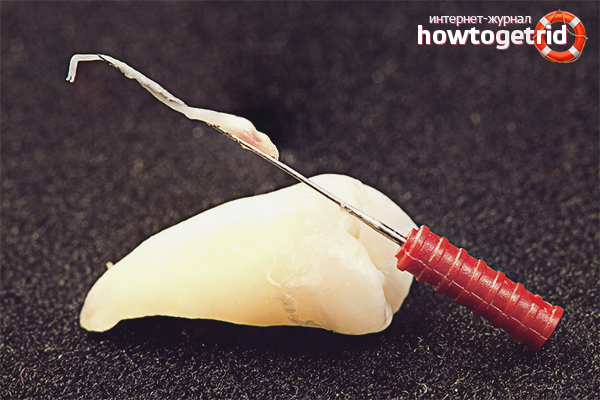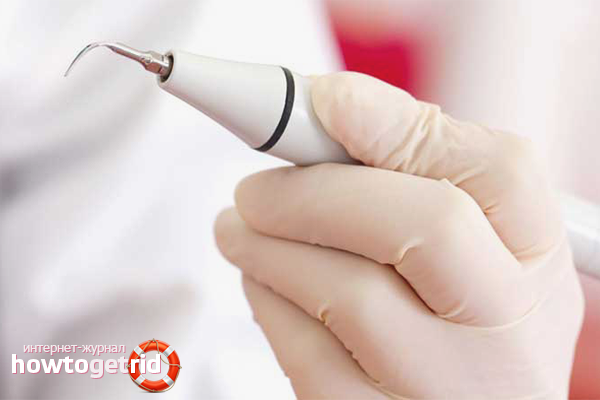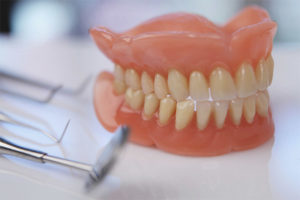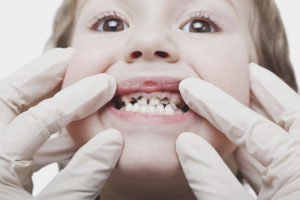The content of the article
According to surveys, most ordinary people are afraid of doctors, but most often we refuse to go to the dentist. Fear of pain or expensive services leads to the fact that patients to the last try to "cure" the tooth on their own, using improvised means. For the sake of justice, I would like to note that this approach is fundamentally wrong. If you go to the dentist in a timely manner and treat dental pathologies in the early stages of development, the cost of a doctor’s services will be quite acceptable. In this article we will talk about the dental nerve - what it is, why and in what cases it needs to be removed, and also we will talk about ways of professional and home removal of nerves.
Dental nerve and its functions
We see the tooth from the outside, it is hard and quite strong. In fact, hardness is ensured by enamel - a hard surface that protects the tooth from external influences, food, etc. The structure of the tooth itself consists of dentin - a softer and loose material. Inside the dentin there are many tubules through which blood, lymphatic fluid, and nerve fibers pass. They feed the tooth with oxygen, important trace elements, vitamins. Nerves make a tooth alive. In some cases, exposure or inflammation of the nerve occurs. If the nerve can no longer be saved, it is removed. For this, various medical mechanisms and compounds are used, which we will talk about a little later.
After removal of the nerve, the tooth becomes “dead”. He no longer receives internal nutrition, does not grow. With proper care, such a tooth can last for quite some time - for decades. But over time, he still begins to collapse and crumble. After inflammation and removal of the nerve, the tooth acquires a slightly grayish tint - this can be noticeable against the background of other teeth.
When to remove a nerve
Of course, if you suffer from severe toothache, you need to visit your dentist as soon as possible. However, some patients take extreme measures, removing teeth, caries and dental nerves on their own. This is only permissible if there is no way to visit a doctor. So, in what cases do you need to do depulpation?
- Pulpitis (inflammation of the nerve) most often occurs against the background of caries, which has not been treated for a long time. As a rule, caries begins with increased sensitivity of the teeth, then a white loose structure appears on the tooth surface and, finally, a black carious cavity develops. The tooth at this time hurts, giving signals that the process of its destruction is in progress. But patients, as a rule, take a painkiller pill and do not take any additional measures. Sometimes a carious opening can be located between two teeth and completely invisible. It seems to a person that the tooth is not black, although inside it is almost completely destroyed. If caries is not treated for a long time, but gets to the nerve, which becomes inflamed. This is accompanied by severe pain during eating, when touching a tooth, when exposed to cold, hot and sweet foods.
- Inflammation and education in the soft parts of the gums can also affect the nerve endings, affecting them. A cyst, granuloma, flux, various benign seals can also lead to an inflammatory process in the nerves. Often when touching the affected tissues of a person, an acute pain pierces, similar to a shock. This suggests that the nerve is also inflamed.
- Various mechanical injuries can also lead to exposure of the nerve. If after a blow a piece of tooth enamel was chipped, a naked tooth will be able to react very sharply to touch.
- Very often, dentists kill a nerve before installing a denture or crown. This is done to prevent further inflammatory process under the implant.
Symptoms such as tooth pulsation, pain when touching and exposure to cold and hot testify to damage to the dental nerve. Often the pain is so severe that it is felt on adjacent teeth. Inflammation of the large nerves can lead to pain in the neck and temples. In these cases, you need to rinse your mouth with saline, take a tablet of the pain medication, and the next day, be sure to consult a dentist.
How do dentists clean a nerve
First, let's start with the fact that doctors kill a nerve only in the most extreme case, when it is definitely impossible to save it. If the cause of exposure of the nerve is damage and chipping of the edge of the tooth, the doctor restores the natural shape of the tooth using composite materials. The bare nerve closes and no longer bothers. If the pain is unbearable, most likely, the inflammation has reached such an extent that it is simply impossible to save the pulp. Then dentists are forced to kill and remove the nerve.
A few decades ago, when the teeth were treated without anesthesia, the removal of the nerve was quite painful and long - the operation took place in two stages. First, the patient was drilled the entire carious cavity, access to the nerve was released. Then arsenic was laid inside, and everything was fixed on top with a temporary filling. The patient was released for several days - during this time arsenic killed the inflamed nerve. However, if the poison got on the mucous membrane, it would bring serious pain. Then they removed the temporary seal, cleaned everything, removed the dead nerve and put a permanent seal.
Fortunately, these times have already passed, and we can easily remove the nerve in one visit to the dentist. The doctor also cleans the tooth of caries, kills the nerve with special compounds, removes it with an instrument, and places a seal. Anesthesia allows you to not feel pain from the procedure. The treatment time most often depends on the size of the caries to be drilled. It’s great if you can get to a good doctor. If this is not possible, you have to kill the nerve yourself.
How to kill a nerve at home
Whatever way you are going to remove the inflamed nerve, you first need to get to it. To do this, get rid of the carious cavity. If you still do not intend to see a doctor, prepare a sterile needle and antiseptic. First brush your teeth and toothpaste to remove plaque and food debris. Then disinfect the needle and use it to remove the entire carious cavity from the tooth. To do this, you need to arm yourself with a small mirror in order to be able to thoroughly examine the tooth. The dental nerve is located in the root canal. You can kill him using the following tools.
- Alcohol or vodka. The drink should be high degree, the exhausted composition will not work. Soak a cotton swab in alcohol and insert it into the recess in the tooth. Leave on for 15 minutes - during this time the nerve atrophies.
- Vinegar. The same effect can be achieved with vinegar, it is better to take 10%. Dampen a cotton swab in it and gently push it inside the digged hole. In advance, it is better to protect the mucous membrane of the gums, cheeks and tongue from the effects of vinegar - cover them with a bandage.
- Powder. Gunpowder is a gray powder, which is also able to remove the nerve. To make it convenient to place it in the cavity of the affected tooth, it can be mixed with petroleum jelly and gently push the composition into the root processes. Leave the gunpowder for half an hour, and then remove. Beware of swallowing gunpowder - it is very toxic.
- Arsenic. You can try to remove the nerve with arsenic. However, be careful - it is very toxic and dangerous. Place a piece of the substance in the tooth cavity and leave for several hours. Beware of getting arsenic on the oral mucosa.
- Ammonia. Ammonia will not completely kill the nerve, but will significantly ease the pain and help you wait for the doctor’s visit. Dampen a cotton swab in it and put it on a bad tooth.
- Iodine. This is a rather painful but effective way to get rid of a nerve. Soak a cotton swab in iodine and place it inside the tooth. At first you will feel a sharp pain, which will then subside. So the nerve dies.
- Garlic. By its principle, garlic is similar to iodine. The pulp of chopped garlic is placed in the cavity of the tooth and wait for it to burn the nerve.
- Propolis. Propolis is a very dubious treatment. It is quite soft and plastic, it is easy for them to plug a hole in the tooth, like a filling. However, carbohydrates are an excellent food for bacteria, from such feeding caries will begin to grow with greater force.
After all the manipulations carried out at home, you need to see a doctor as soon as the opportunity presents itself - no longer than in 10-15 days. It will correct the situation, since it is completely impossible to manually drill out caries. In addition, an open hole in the tooth is a great place to collect food debris, the development of bacteria. With home manipulation, tissue infection often occurs. The doctor will thoroughly clean the dentin from the carious residues, remove the nerve, in whatever condition it is, and fill the damaged area of the tooth. Only in this case can you be sure that you will not have complications.
An inflamed nerve can really bring aching, sharp and exhausting pain, which can not be avoided. Removing nerves on your own is justified only if you are at the North Pole and there are no doctors around for thousands of kilometers. In other cases, try to get to the dentist and get safe and qualified help.
Video: how to relieve toothache and not pull out a tooth











Submit